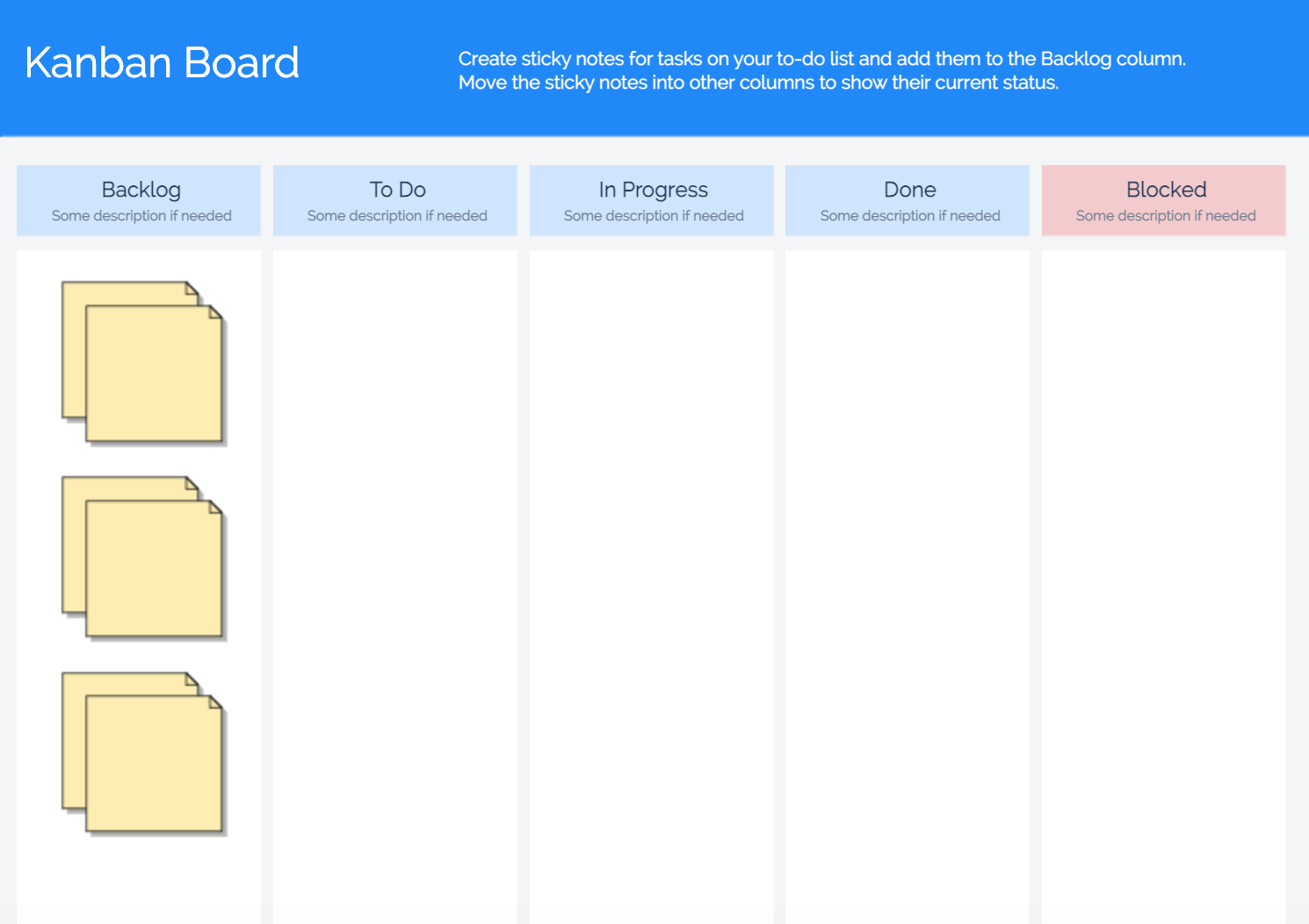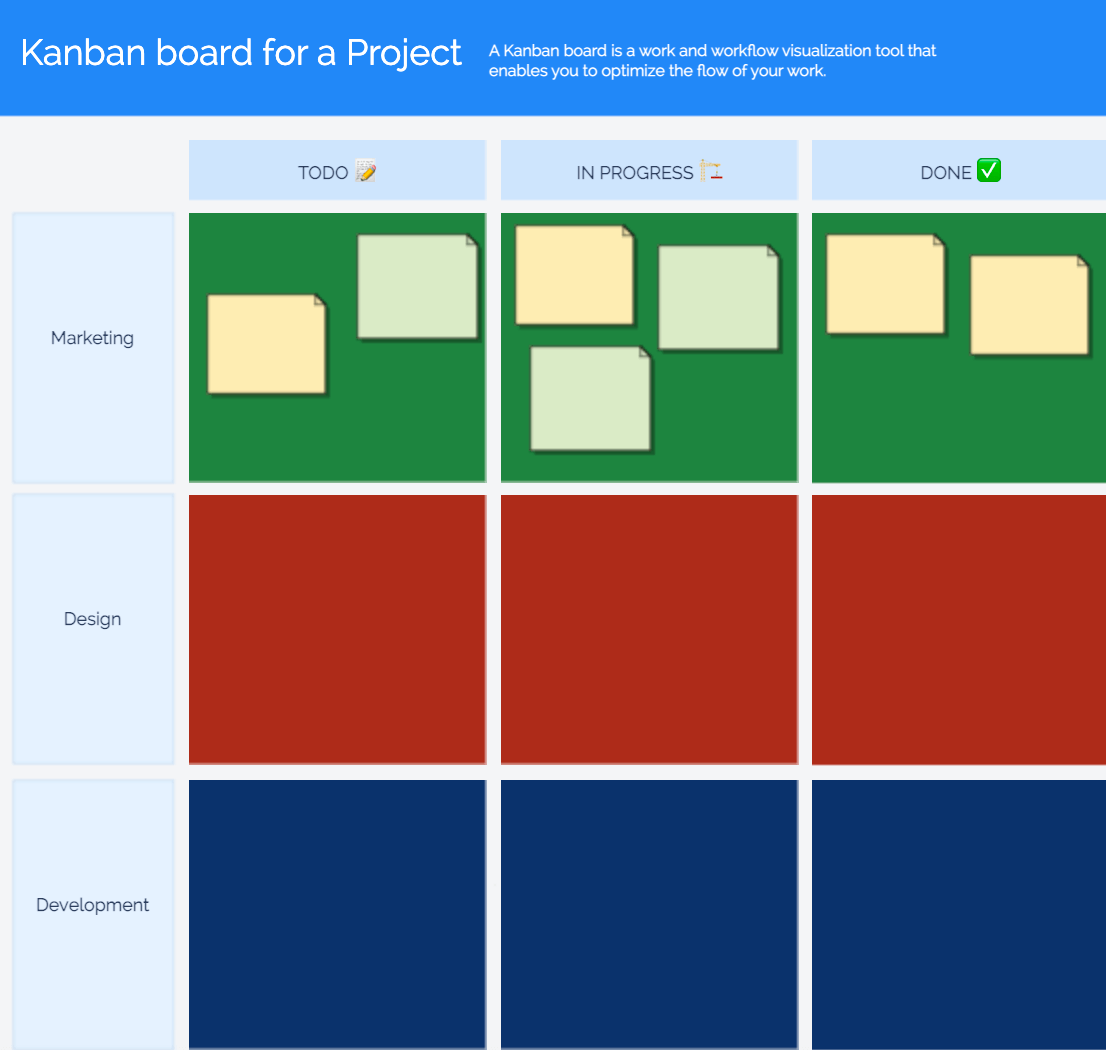What is a Kanban Board?
A Kanban board is a visual tool for Agile teams to capture their workload and task flow at a glance.
Kanban boards provide necessary structure for the larger concept of the Kanban framework, which focuses on work as continuous improvement and a steady flow of activities, rather than the defined sprints of time that define the Scrum methodology.
This idea of continuous improvement means that team members pull new tasks from the backlog as soon as they finish their current task for a constant stream of activity that has no defined start or end period.
Kanban is an especially popular framework for product engineering and software development teams as they work to continuously build value for their users, but any team can adopt the Kanban framework and use Kanban boards to facilitate and organize a flexible workflow.
Back to topElements of the Kanban Board
One advantage of Kanban boards is their flexibility. There’s no one right way to make one, and they can be adapted to fit the way your team works. However, there are a few common elements that almost any Kanban board should have.
Cards
Cards represent tasks and contain information about a task, such as who it’s assigned to and sometimes even a short description. Cards often take the form of sticky notes that can easily be moved (on a physical whiteboard) or dragged and dropped (on a digital Kanban board) to different parts of the board to represent the task’s progress throughout different stages.
Columns
Columns represent different stages of work and provide a structure to the Kanban board that determines where cards are placed as they move through the workflow. In most cases, the first column is a “Backlog” column where all future work and ideas are stored until it’s time for work to begin.
Then, there’s often a “To Do” or “Ready to Start” column that represents the entry point or commitment point — the point at which the task enters the workflow and a member of the team begins to work on it. Other columns can include “In Progress” or “Blocked.” These columns help all team members understand the status of a task at all times.
When a task reaches its delivery point — the time at which work is done and the result is ready to be delivered — it can be placed in the “Done” Column. When a team member finishes a task and moves it into the “Done” column, they can pull their next task from the backlog and start again.
Work in Progress (WIP) Limits
Work in Progress, or WIP, limits are the maximum number of cards that can occupy a column at any given time. These limits exist to keep the team focused on the most important tasks, avoiding multitasking that spreads the team too thin. They can also help with identifying and resolving bottlenecks and blockers quickly for a more efficient workflow and faster delivery.
Back to topWhy Do Teams Use Kanban Boards?
A Kanban board allows any team member to see the status of their teammates’ work at a glance, providing important clarity for remote and hybrid teams, who may not even work in the same time zone and don’t have many opportunities to connect in person.
The context that a Kanban board provides is especially helpful for software engineering and product development teams, since their work is often intangible.
Kanban boards also help teams focus on the work that needs to get done by eliminating the need for frequent status meetings. When anyone can check in on the board to see the most up-to-date information, there’s no need to meet to align on the status of tasks unless issues or bottlenecks arise.
Kanban boards introduce flexibility not only in the way communication happens, but also in how the actual work is done. The continuous model of the Kanban framework is much less restrictive than the Scrum model, with its defined due dates of sprints.
Adopting this framework and using collaboration tools, such as virtual Kanban boards, to manage it effectively is a great way to increase sustainable productivity.
Back to topTry These Kanban Templates for Confluence
Using a Kanban template gives you a starting point which you can build on or add to based on how your individual team works. These templates are available in Gliffy for Confluence Cloud, and you can access them by creating a new Gliffy diagram on any Confluence page and selecting the “Kanban” category from the left side of the panel.
Simple Kanban Board
The Simple Kanban Board template has all the basic elements of a typical board — backlog, to do, in progress, done, and blocked. You can drag and drop sticky notes to their respective columns as the status of the task changes, so the team always stays updated. Use this template as is, or customize as necessary by adding extra columns or descriptions.

Project Kanban Board
The Project Kanban Board template is a cross-functional version of a Kanban board that allows members of different teams to keep each other up to date on the status of their respective parts of a project. This helps reduce information silos and encourage better visibility.

Finished your project? Wrap things up with one of our retrospective templates >>
Back to top
Customizing Your Kanban Boards
There are a few ways you can further customize your Kanban board to get a more detailed view of a task flow.
First, you can implement swimlanes that separate different teams, products, classes, or other categories that are relevant to your team. You can also create swimlanes that represent prioritization of tasks with high, low, and medium priority lanes.
Another way to prioritize tasks on a Kanban board is by color coding sticky notes with different levels of priority.
Back to topMaking the Most of Your Kanban Boards
In order to get the most out of your Kanban board, you’ll want to make sure that your team uses and manages it effectively.
First, as you get started with the Kanban framework, establish a structure for how you will add new tasks to the backlog and how you will review tasks that are currently in the backlog.
You could have a feedback process for adding newly discovered ideas, or you could hold team meetings to go over new ideas, capturing ideas with a collaborative brainstorming session.
While reviewing the backlog, make sure to add new ideas that the team has agreed on, remove old tasks that may not be relevant anymore, and merge or break down tasks as needed to get them to a manageable size.
This is important because you don’t want to have some tasks that take hours longer than others — each card should have a similar scope.
Back to topStart Your Own Board Today
If your team is ready to implement the Kanban framework to your daily workflow, you’ll need a place to organize and visualize all your work.
And if your team already works in the Atlassian ecosystem, you don’t need to add any extra collaboration tools to make it happen — Gliffy is directly integrated with Confluence, so your boards can live in the same space as the rest of your documentation.
Does your Agile team use the Scrum framework instead? Check out our Scrum board templates for Confluence or learn more about Agile Ceremonies >>